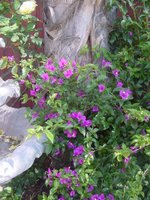Bougainvillea

Bougainvillea is a genus of flowering plants native to the tropical and subtropical regions of South America from Brazil west to Peru and south to southern Argentina (Chubut Province). Different authors accept between four and 18 species in the genus. Its name comes from Louis Antoine de Bougainville, an admiral in the French Navy who discovered the plant in Brazil in 1768.
They are thorny, woody, vines growing to 1-12 m tall, scrambling over other plants with the hooked thorns. They are evergreen where rainfall occurs all year, or deciduous in the dry season. The leaves are alternate, simple ovate-acuminate, 4-13 cm long and 2-6 cm broad. The actual flower of the plant is small and generally white, but each cluster of three flowers is surrounded by three or six bracts with the bright colors associated with the plant, including pink, magenta, purple, red, orange, white, or yellow. Bougainvillea glabra is sometimes referred to as "paper flower" because the bracts are thin and papery. The fruit is a narrow five-lobed achene.
Cultivation and uses
Bougainvillea are popular plants in California, south Texas, Florida, the Caribbean, South Africa, Australia, and other areas with warm climates.
Numerous cultivars and hybrids have been selected, including nearly thornless shrubs. Some Bougainvillea cultivars are sterile, and are propagated from cuttings.
Bougainvillea are rapid growing and flower all year in warm climates, especially when pinched or pruned. Bloom cycles are typically four to six weeks. Bougainvillea grow best in very bright full sun and with frequent fertilization, but the plant requires little water to flower. As indoor houseplants in temperate regions, they can be kept small by bonsai techniques. If overwatered, Bougainvillea will not flower and may lose leaves or wilt, or even die from root decay.

0 Comments:
Post a Comment
<< Home